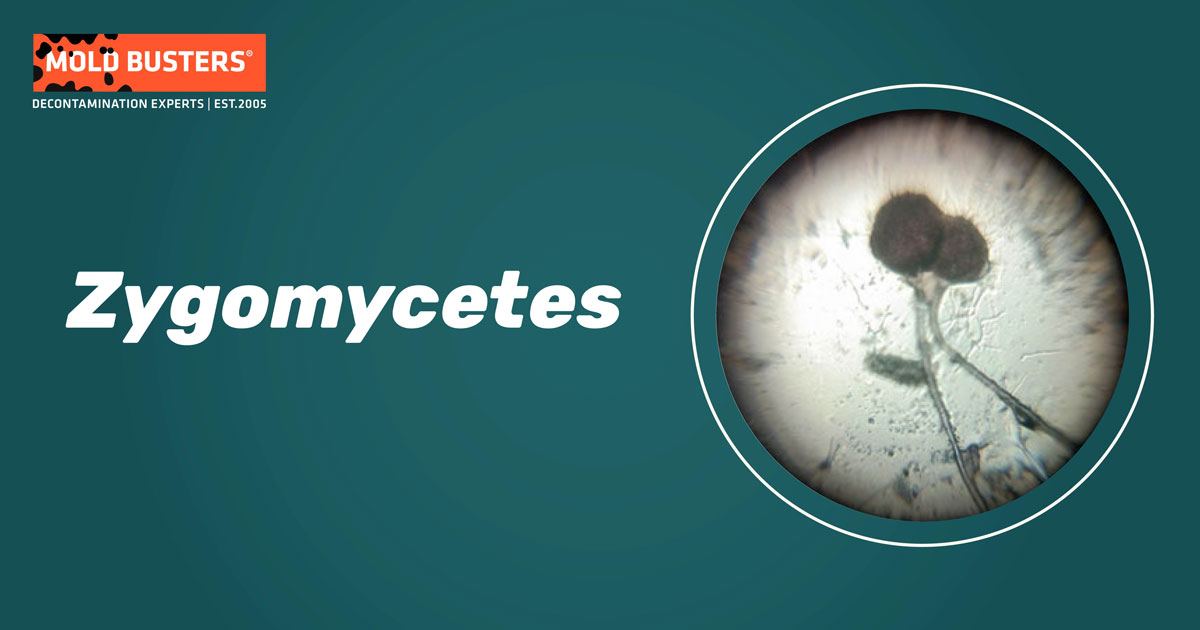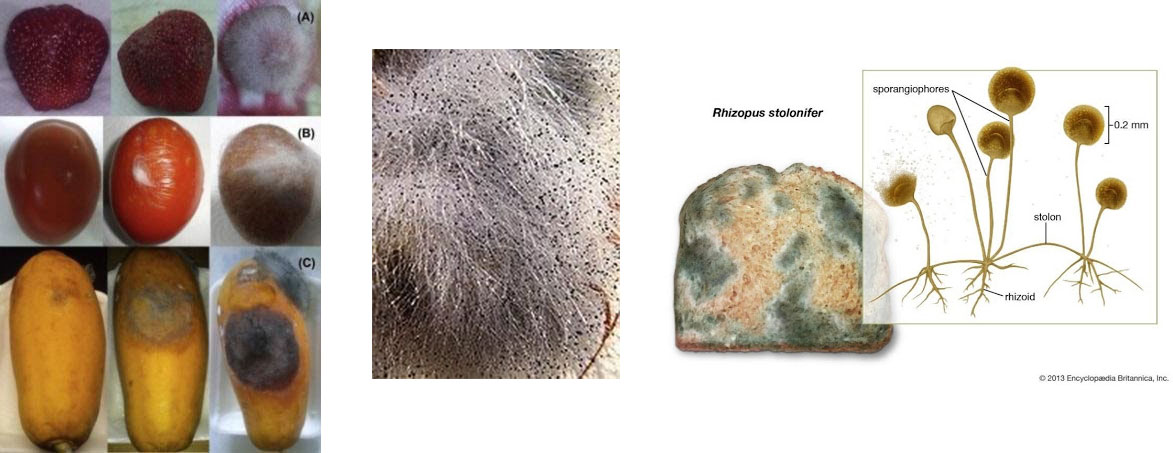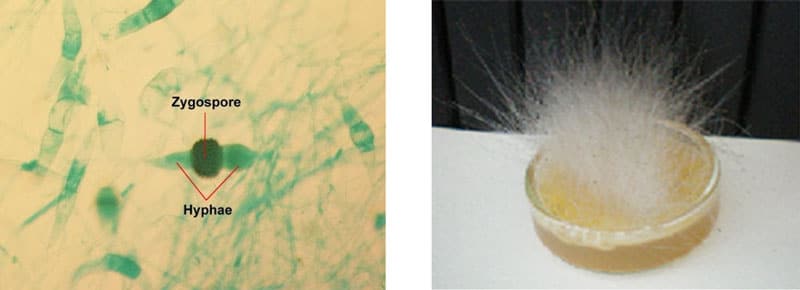With today’s fast-paced lifestyle, it is hard to even notice what is going on around us. In an effort to maintain a high quality of life, we usually do not notice the constantly present but less visible phenomena that have a direct impact on our health.
So it is with molds. Living with such a large number of molds in our living spaces, even though we are not aware of it, it is very important to find out more about it and take preventive care.

What is Zygomycetes?
Zygomycetes belong to the phylum Zygomycota or conjugation fungi, which includes molds. This class includes various types of fungi that can be found throughout the world.
Zygomycetes are economically important. Some of them are used in the fermentation of food products, while others are used for the production of enzymes, acids, and so on. [1] Saprophytic species of zygomycetes spoil our food while others are human pathogens.
Where can Zygomycetes fungi be found?
These fungi can be found practically everywhere: in soil, dung, grass, fibre, wood, decaying plant material, paper, textiles, indoor and outdoor air, hospitals, and occasionally in water-damaged buildings. Zygomycetes grow indoors on materials that are rich in cellulose, such as plasterboard, paper, paints, and fabrics.
These fungi are also commonly found in the digestive tract of aquatic larvae of a broad spectrum of insects, crustaceans, and other arthropods, which act as hosts for the fungi. [2] Rhizopus stolonifer, known as a black bread mold, is a common zygomycete. Decomposed bread, fruit, vegetables, and animals decay and create a black growth on its surface.

Zygomycetes classification
The name “zygomycetes” refers to spores with thick walls known as zygospores. Within this class, there are more than 800 species that are divided into seven orders:[3]
- Mucorales
– Mucoraceae
– Cunninghamellaceae - Entomophthorale
– Ancylistaceae - Demorgaritales
- Kickxellales
- Endogonales
- Zoopagales
- Harpellales
Zygomycetes characteristics
Zygomycetes organisms belong to a unique group of conjugated fungi. Most have coenocytic hyphae with a fast-flowing cytoplasm. The primary component of their cell wall is chitin, and the primary storage polysaccharide in the cytoplasm is glycogen. There is a lack of any motile cells at any stage of their life cycle.
Zygomycetes are able to reproduce both by the sexual formation of zygospores and asexually by aplanospores (also called sporangiospores) or conidia.
Zygospores are formed through the complete protoplast fusion of two equal or unequal gametangium. [4] They remain dormant and protected by thick layers until environmental conditions improve. When conditions become favourable, zygospores undergo meiosis to produce haploid spores, which will eventually grow into a new organism. This form of sexual reproduction in fungi is called conjugation (hence, the term “conjugated” fungi).
Asexual reproduction of this fungi occurs through the spread of spores by animals or the wind.

What are the health effects of Zygomycetes?
Zygomycetes may adversely affect humans, animals, and plants. Those who are most sensitive are people with weakened immune systems.
Furthermore, any type of skin trauma, wound, needle, or burn may increase the risk of zygomycetes-related conditions, including:
- Angioinvasive disease
- Sinusitis
- Subcutaneous mycosis
- Infections of the gastrointestinal tract, lymph nodes and muscles
- Infections of the cavities of the face and nose and mouth
Zygomycetes infections
There are two orders of zygomycetes-containing organisms that affect human health:Mucorales and Entomophthorales. Most human diseases are caused by Mucorales. [5] While diseases are most often associated with Rhizopus spp., other species have also been associated with human infection, including Mucor, Rhizomucor, Absidia, Apophisomices, Sakenaea, Cunninghamella, Cokeromices, and Sincephalastrum spp. Exposure to these mold spores can occur by inhalation, various percutaneous pathways, or ingestion of spores.
What is Mucormycosis?
Mucormycosis, also known as zygomycosis, is a fungal infection that can be acquired by contact with fungal spores in the environment. [6] For example, lung or sinus infections can occur after slow, consistent inhalation of fungal spores. Forms of mucormycosis may occur in people who have health issues or are taking medications that reduce the body’s ability to fight germs and disease. [7] Infection may also develop on the skin after the fungus enters through cuts, abrasions, burns, or other skin wounds.
Types of mucormycosis:
- Rhinocerebral mucormycosis is a sinus infection that can spread to the brain. Most common in people with uncontrolled diabetes and who have had a kidney transplant.[8]
- Pulmonary mucormycosis is most commonly observed in immunocompromised patients. Patients are usually infected after inhaling spores.
- Gastrointestinal mucormycosis is more common among young children than adults.[9-10]
- Cutaneous mucormycosis occurs after the fungi enter the body through a break in the skin (e.g. after surgery, a burn, or other type of skin trauma).
- Disseminated mucormycosis is an infection that affects the brain but that can also affect other organs such as the spleen, heart, and skin.
How to get rid of Zygomycetes?
If you have found mold growing in your home, you should clean the mold and repair any moisture-related issues (e.g. leaky pipes, roofs, or appliances) immediately. Humidity control in your home is also one of the most important factors in preventing mold growth. Depending on the size of the mold contamination and the level of damage, mold cleanup may or may not require professional help. Mold Busters can help—contact us today to learn about our wide range of mold removal and decontamination services.

Did you know?
The #1 toxic mold type found in homes is the Penicillium/Aspergillus mold group?! Find out more exciting mold stats and facts inside our mold statistics page.
References
- Jose M. Lorenzo, Paulo E. Munekata,Ruben Dominguez,Mirian Pateiro,Jorge A. Saraiva, and Daniel Franco; Innovative Technologies for Food Preservation. 2018 : 53–107;
- Encyclopedia of Food Microbiology (Second Edition) 2014, Pages 54-67;
- Voigt and Kirk 2014Fungi: Classification of Zygomycetes: Reappraisal as Coherent Class Based on a Comparison between Traditional versus Molecular Systematics; 01410.1016/B978-0-12-384730-0.00136-1 2014 Pages 54-67;
- JOHN C.KRUGGERALD L.BENNYHAROLD W.KELLERBiodiversity of Fungi;Inventory and Monitoring Methods;2004, Pages 467-499
- Julie A. Ribes, Carolyn L. Vanover-Sams, and Doris J. Baker; Zygomycetes in Human Disease; 10.1128/cmr.13.2.236-301.2000; 2000 Apr; 13(2): 236–301.
- Richardson M. The ecology of the Zygomycetes and its impact on environmental exposure;Clin Microbiol Infect. 2009 Oct;15 Suppl 5:2-9.
- Petrikkos G, Skiada A, Lortholary O, Roilides E, Walsh TJ, Kontoyiannis DP. Epidemiology and clinical manifestations of mucormycosis; Clin Infect Dis. 2012 Feb;54 Suppl 1:S23-34.
- Vallabhaneni S, Mody RK. Gastrointestinal mucormycosis in neonates: a review. Current Fungal Infect Rep. 2015
- Francis JR, Villanueva P, Bryant P, Blyth CC. Mucormycosis in children: review and recommendations for management;J Pediatric Infect Dis Soc. 2018 May 15;7(2):159-164.
- Song Y, Qiao J, Giovanni G, Liu G, Yang H, Wu J, Chen J. Mucormycosis in renal transplant recipients: review of 174 reported cases. BMC Infect Dis. 2017 Apr; 17(1): 283.

Get Special Gift: Industry-Standard Mold Removal Guidelines
Download the industry-standard guidelines that Mold Busters use in their own mold removal services, including news, tips and special offers:

Written by:
John Ward
Account Executive
Mold Busters
Fact checked by:
Michael Golubev
General Manager
Mold Busters
